Abstract
We have isolated from pig intestine a 60-residue polypeptide initially identified by its inhibition of glucose-induced insulin secretion from perfused pancreas. The amino acid sequence of this porcine polypeptide was determined and found to be markedly similar to that of the pancreatic secretory trypsin inhibitor (41% residue identities). Furthermore, the disulfide arrangements of these two proteins appear identical, suggesting related overall conformations. However, the polypeptide, now named PEC-60 (peptide with N-terminal glutamic acid, C-terminal cysteine, and a total of 60 residues), was found not to inhibit trypsin. The amino acid sequence is also similar to that of a peptide recently isolated from rat bile/pancreatic juice which stimulates the release of cholecystokinin. The biological role of PEC-60 is not known, but the effect on insulin secretion and the homologies observed suggest important biological activities and interesting structural relationships.
Full text
PDF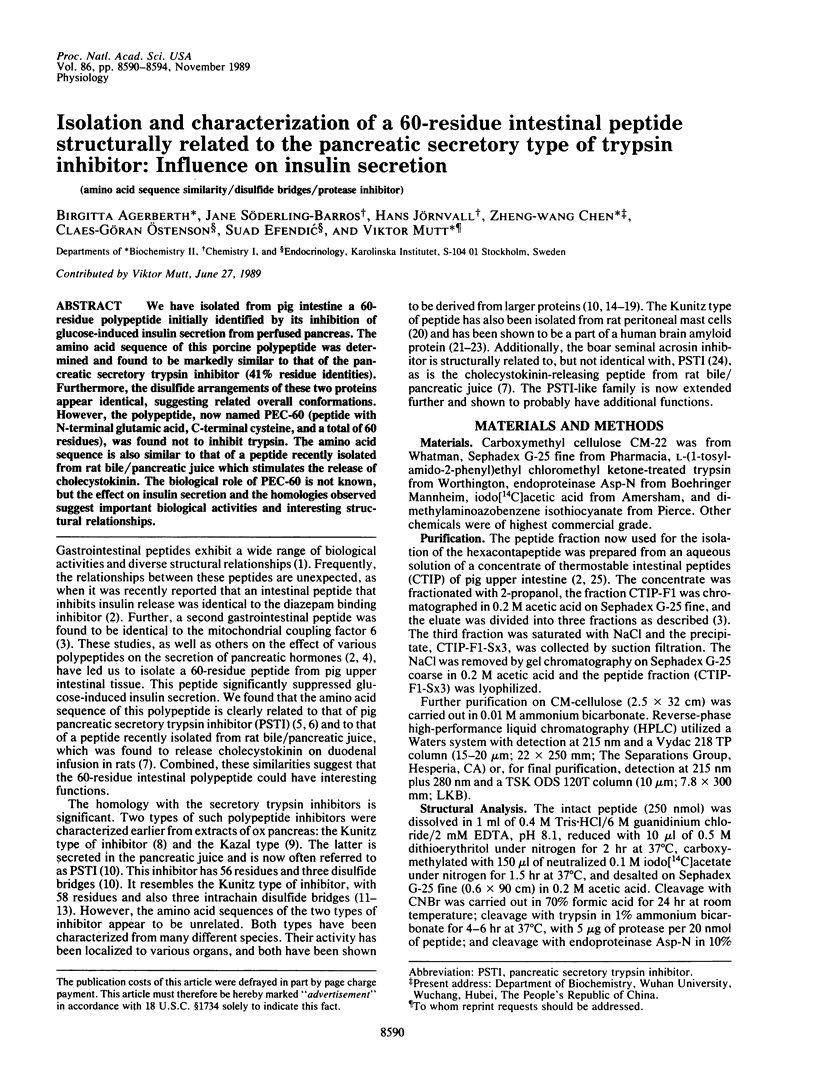
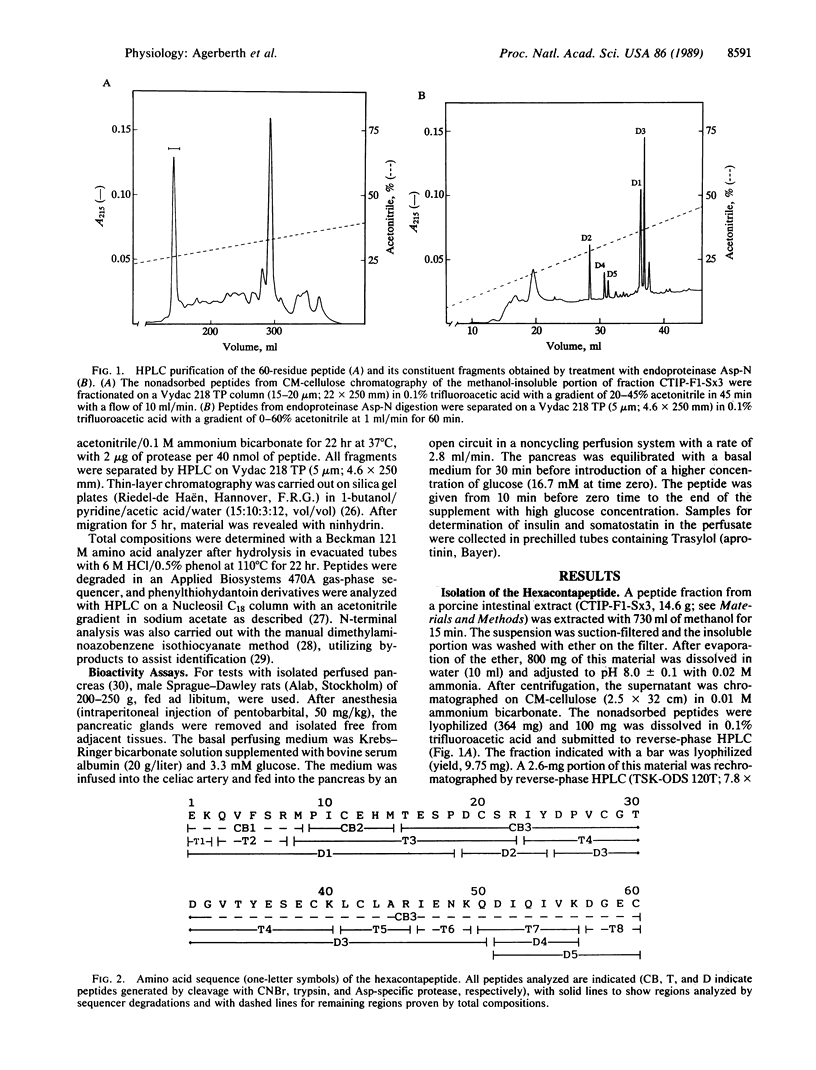
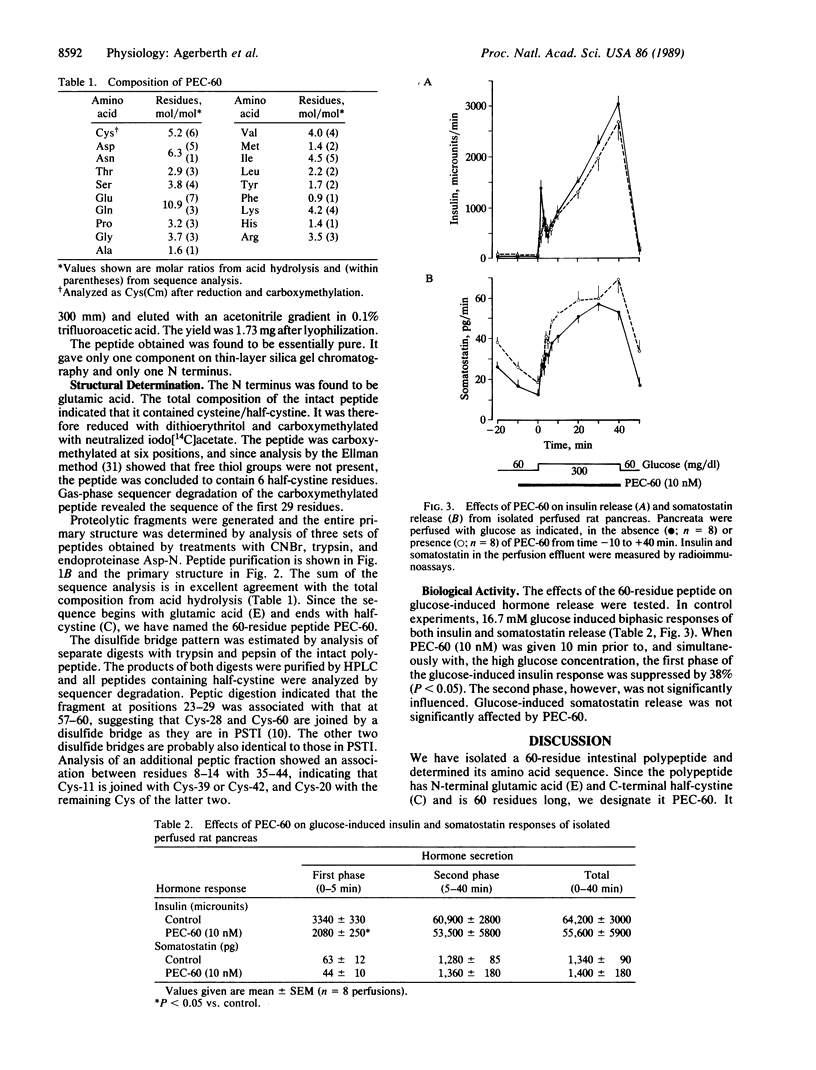
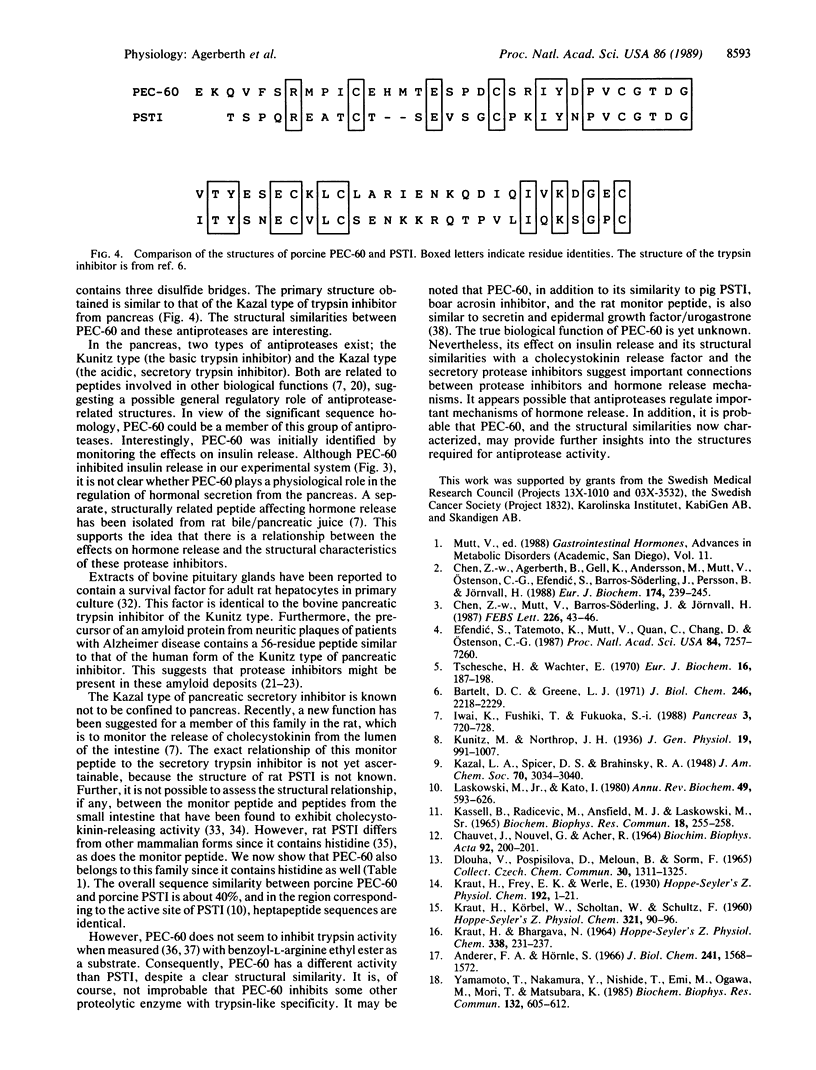
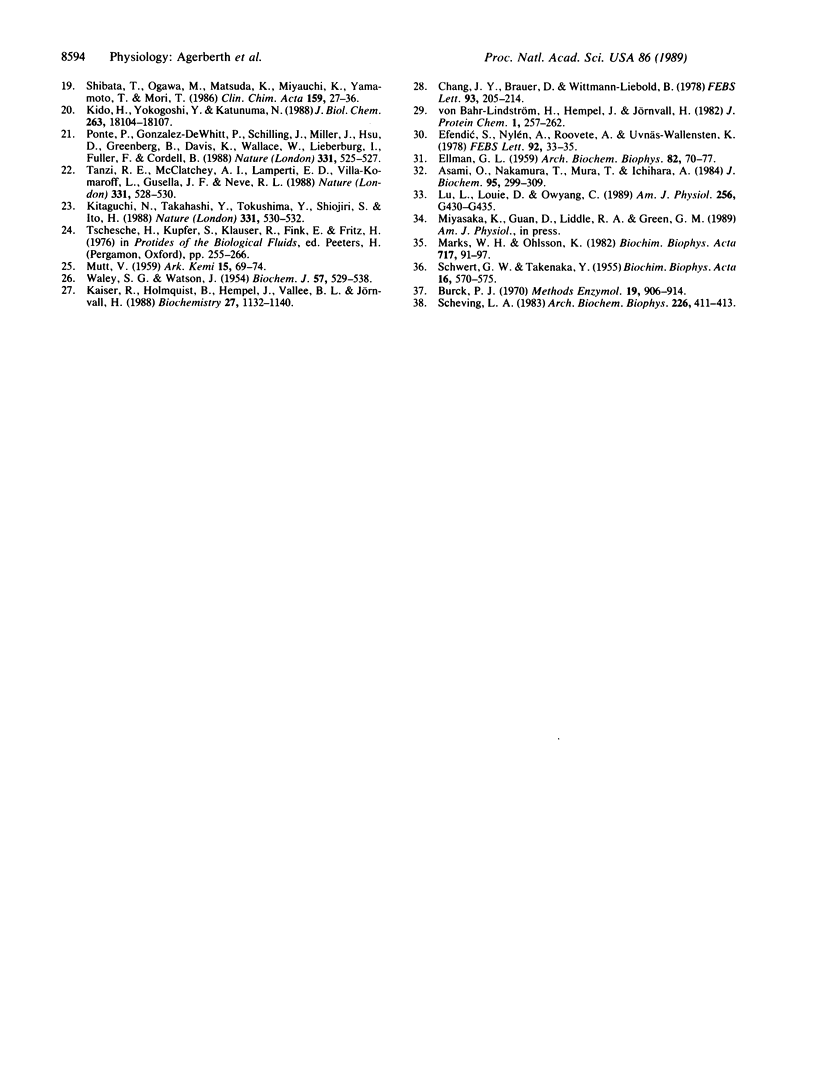
Selected References
These references are in PubMed. This may not be the complete list of references from this article.
- Anderer F. A., Hörnle S. The disulfide linkages in kallikrein inactivator of bovine lung. J Biol Chem. 1966 Apr 10;241(7):1568–1572. [PubMed] [Google Scholar]
- Asami O., Nakamura T., Mura T., Ichihara A. Identification of trypsin inhibitor in bovine pituitary extracts as a survival factor for adult rat hepatocytes in primary culture. J Biochem. 1984 Feb;95(2):299–309. doi: 10.1093/oxfordjournals.jbchem.a134609. [DOI] [PubMed] [Google Scholar]
- Bartelt D. C., Greene L. J. The primary structure of the porcine pancreatic secretory trypsin inhibitor. I. Amino acid sequence of the reduced S-aminoethylated protein. J Biol Chem. 1971 Apr 10;246(7):2218–2229. [PubMed] [Google Scholar]
- CHAUVET J., NOUVEL G., ACHER R. STRUCTURE PRIMAIR D'UN INHIBITEUR PANCR'EATIQUE DE LA TRYPSINE (INHIBITEUR DE KUNITZ ET NORTHROP) Biochim Biophys Acta. 1964 Oct 23;92:200–201. [PubMed] [Google Scholar]
- Chen Z. W., Agerberth B., Gell K., Andersson M., Mutt V., Ostenson C. G., Efendić S., Barros-Söderling J., Persson B., Jörnvall H. Isolation and characterization of porcine diazepam-binding inhibitor, a polypeptide not only of cerebral occurrence but also common in intestinal tissues and with effects on regulation of insulin release. Eur J Biochem. 1988 Jun 1;174(2):239–245. doi: 10.1111/j.1432-1033.1988.tb14088.x. [DOI] [PubMed] [Google Scholar]
- Chen Z. W., Mutt V., Barros-Söderling J., Jörnvall H. Isolation and structural characterization of porcine coupling factor 6 from intestinal tissues. FEBS Lett. 1987 Dec 21;226(1):43–46. doi: 10.1016/0014-5793(87)80547-1. [DOI] [PubMed] [Google Scholar]
- ELLMAN G. L. Tissue sulfhydryl groups. Arch Biochem Biophys. 1959 May;82(1):70–77. doi: 10.1016/0003-9861(59)90090-6. [DOI] [PubMed] [Google Scholar]
- Efendić S., Nylén A., Roovete A., Uvnäs-Wallenstein K. Effects of glucose and arginine on the release of immunoreactive somatostatin from the isolated perfused rat pancreas. FEBS Lett. 1978 Aug 1;92(1):33–35. doi: 10.1016/0014-5793(78)80715-7. [DOI] [PubMed] [Google Scholar]
- Efendić S., Tatemoto K., Mutt V., Quan C., Chang D., Ostenson C. G. Pancreastatin and islet hormone release. Proc Natl Acad Sci U S A. 1987 Oct;84(20):7257–7260. doi: 10.1073/pnas.84.20.7257. [DOI] [PMC free article] [PubMed] [Google Scholar]
- Iwai K., Fushiki T., Fukuoka S. Pancreatic enzyme secretion mediated by novel peptide: monitor peptide hypothesis. Pancreas. 1988;3(6):720–728. doi: 10.1097/00006676-198812000-00013. [DOI] [PubMed] [Google Scholar]
- KASSELL B., RADICEVIC M., ANSFIELD M. J., LASKOWSKI M., Sr THE BASIC TRYPSIN INHIBITOR OF BOVINE PANCREAS. IV. THE LINEAR SEQUENCE OF THE 58 AMINO ACIDS. Biochem Biophys Res Commun. 1965 Jan 18;18:255–258. doi: 10.1016/0006-291x(65)90749-7. [DOI] [PubMed] [Google Scholar]
- KRAUT H., BHARGAVA N. VERSUCHE ZUR ISOLIERUNG DES KALLIKREIN-INAKTIVATORS. V. ISOLIERUNG EINES KALLIKREIN-INAKTIVATORS AUS RINDERLUNGE UND SEINE IDENTIFIZIERUNG MIT DEM INAKTIVATOR AUS RINDERPAROTIS. Hoppe Seylers Z Physiol Chem. 1964;338:231–237. doi: 10.1515/bchm2.1964.338.1-2.231. [DOI] [PubMed] [Google Scholar]
- KRAUT H., KOERBEL W., SCHOLTAN W., SCHULTZ F. [Attempts at the isolation of the kallikrein inactivator. III. Electrophoretic purification and molecular weight determination in the ultracentrifuge]. Hoppe Seylers Z Physiol Chem. 1960 Dec 2;321:90–96. doi: 10.1515/bchm2.1960.321.1.90. [DOI] [PubMed] [Google Scholar]
- Kaiser R., Holmquist B., Hempel J., Vallee B. L., Jörnvall H. Class III human liver alcohol dehydrogenase: a novel structural type equidistantly related to the class I and class II enzymes. Biochemistry. 1988 Feb 23;27(4):1132–1140. doi: 10.1021/bi00404a009. [DOI] [PubMed] [Google Scholar]
- Kido H., Yokogoshi Y., Katunuma N. Kunitz-type protease inhibitor found in rat mast cells. Purification, properties, and amino acid sequence. J Biol Chem. 1988 Dec 5;263(34):18104–18107. [PubMed] [Google Scholar]
- Kitaguchi N., Takahashi Y., Tokushima Y., Shiojiri S., Ito H. Novel precursor of Alzheimer's disease amyloid protein shows protease inhibitory activity. Nature. 1988 Feb 11;331(6156):530–532. doi: 10.1038/331530a0. [DOI] [PubMed] [Google Scholar]
- Laskowski M., Jr, Kato I. Protein inhibitors of proteinases. Annu Rev Biochem. 1980;49:593–626. doi: 10.1146/annurev.bi.49.070180.003113. [DOI] [PubMed] [Google Scholar]
- Lu L., Louie D., Owyang C. A cholecystokinin releasing peptide mediates feedback regulation of pancreatic secretion. Am J Physiol. 1989 Feb;256(2 Pt 1):G430–G435. doi: 10.1152/ajpgi.1989.256.2.G430. [DOI] [PubMed] [Google Scholar]
- Marks W. H., Ohlsson K. Isolation and partial characterization of the pancreatic secretory trypsin inhibitor in the rat. Biochim Biophys Acta. 1982 Jul 16;717(1):91–97. doi: 10.1016/0304-4165(82)90384-1. [DOI] [PubMed] [Google Scholar]
- Ponte P., Gonzalez-DeWhitt P., Schilling J., Miller J., Hsu D., Greenberg B., Davis K., Wallace W., Lieberburg I., Fuller F. A new A4 amyloid mRNA contains a domain homologous to serine proteinase inhibitors. Nature. 1988 Feb 11;331(6156):525–527. doi: 10.1038/331525a0. [DOI] [PubMed] [Google Scholar]
- SCHWERT G. W., TAKENAKA Y. A spectrophotometric determination of trypsin and chymotrypsin. Biochim Biophys Acta. 1955 Apr;16(4):570–575. doi: 10.1016/0006-3002(55)90280-8. [DOI] [PubMed] [Google Scholar]
- Scheving L. A. Primary amino acid sequence similarity between human epidermal growth factor-urogastrone, human pancreatic secretory trypsin inhibitor, and members of porcine secretin family. Arch Biochem Biophys. 1983 Oct 15;226(2):411–413. doi: 10.1016/0003-9861(83)90309-0. [DOI] [PubMed] [Google Scholar]
- Shibata T., Ogawa M., Matsuda K., Miyauchi K., Yamamoto T., Mori T. Purification and characterization of pancreatic secretory trypsin inhibitor in human gastric mucosa. Clin Chim Acta. 1986 Aug 30;159(1):27–36. doi: 10.1016/0009-8981(86)90163-4. [DOI] [PubMed] [Google Scholar]
- Tanzi R. E., McClatchey A. I., Lamperti E. D., Villa-Komaroff L., Gusella J. F., Neve R. L. Protease inhibitor domain encoded by an amyloid protein precursor mRNA associated with Alzheimer's disease. Nature. 1988 Feb 11;331(6156):528–530. doi: 10.1038/331528a0. [DOI] [PubMed] [Google Scholar]
- Tschesche H., Wachter E. The structure of the porcine pancreatic secretory trypsin inhibitor. I. A sequence determination by Edman degradation and mass spectral identification of the p-bromophenyl-thiohydantoins. Eur J Biochem. 1970 Sep;16(1):187–198. doi: 10.1111/j.1432-1033.1970.tb01071.x. [DOI] [PubMed] [Google Scholar]
- WALEY S. G., WATSON J. Trypsin-catalysed transpeptidations. Biochem J. 1954 Aug;57(4):529–538. doi: 10.1042/bj0570529. [DOI] [PMC free article] [PubMed] [Google Scholar]
- Yamamoto T., Nakamura Y., Nishide J., Emi M., Ogawa M., Mori T., Matsubara K. Molecular cloning and nucleotide sequence of human pancreatic secretory trypsin inhibitor (PSTI) cDNA. Biochem Biophys Res Commun. 1985 Oct 30;132(2):605–612. doi: 10.1016/0006-291x(85)91176-3. [DOI] [PubMed] [Google Scholar]


